Available theses
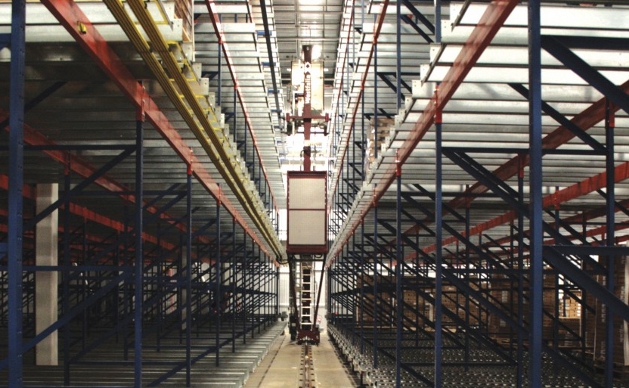
Multi-depth Automated Storage and Retrieval System (ASRS) with variable width
Starting from a realistic model of such complex and novel ASRS developed by an industrial partner, the thesis focus is to develop and test multiple storing and picking planning algorithms in order to maximize the overall system throughput. Moreover, the project concerns a field implementation phase of a supervisory control for the storage missions management. A passionate student characterized by a high engineering creativity is recommended for this task.
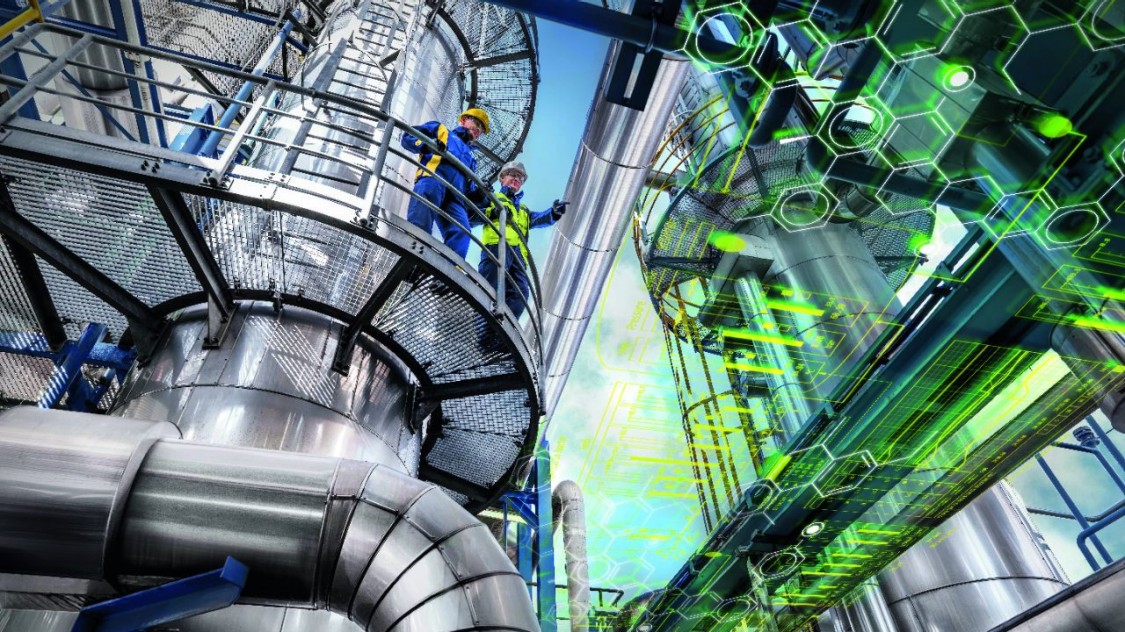
Plant-wise efficiency optimization for chemical processes
Facing a complex and wide industrial context, the student is asked to identify the key variables of the proposed process and deploy a sub-optimal control which can increase the overall plant productivity. Concerning the control-oriented approach that will be adopted, any lack of chemical knowledge should not discourage the student from applying for this thesis job. The specific applications for this proposal concern a Mono-Ethylene-Glycol (MEG) unit or a Polyethylene Terephthalate (PET) unit. Such context makes it possible to study the applicability of advanced modeling and control techniques, such as artificial neural network or reinforcement learning. Students with a high level of investigative capability and able to see the process wider picture are sought after.

Multi-objective control of a non-linear industrial steam generator model
Concerning an industrial steam generator equipped with a cutting-edge heat recovery system, the work focuses on designing a robust control strategy capable of identifying the time-variant maximum efficiency work point. Moreover, an innovative hybrid control structure can be studied and implemented to minimize the generator actuators mechanical stress. A strongly non-linear dynamic model of the whole steam generator (including the heat recovery system) is already available. A high level of resourcefulness and control-field ability is expected to carry out this project.

Reinforcement Learning for control system applications
Concerning the Reinforcement Learning (RL) approach to the control field – which can be defined as a model-free framework for solving optimal control problems – this proposal suits a variety of applications. The student is able to investigate the applicability and performances of such technique on almost any of the fields cited in the other thesis proposals: industrial steam generators, industrial chemical processes (MEG, PET), heat pumps, buildings and so on. A student passionate about control theory and its application can fully appreciate the wide applicative range of this proposal.

PoliMi’s Building 25 thermal network modeling and control
Regarding the well-known Building 25 in Via Golgi and the associated European research project eSmartCity, the proposed thesis work can focus on different topics:
• Application of advanced modeling techniques to provide a reliable building model starting from the available data collected on the building itself;
• Developing user-friendly data monitoring systems which are able to capture different performances indexes on the building real-time behaviour;
• Design advanced control strategies able to exploit the thermal network complexity (fan coils, air recirculation and handling systems, heat pumps…) to maximize the user comfort and the building energy efficiency.

IoT sensors networks
Optimize an existing IoT sensors grid by developing and integrating a Data Monitoring system. Afterwards, a data collection phase should follow, aiming at performance analysis and fault detection. An immediate test case is ready (Building 25) for which real multi-sensors are already available and installed.
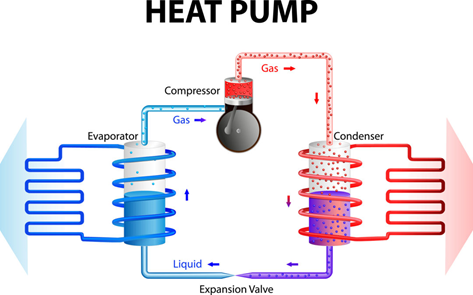
Heat pumps non-linear model and control
Starting from a validated prototype non-linear model of a domestic heat pump, try to deploy a multi-objective control strategy for such device. Moreover, it is possible to study the enlargement of such model to the industrial heat pump installed in Building 25.
Published theses
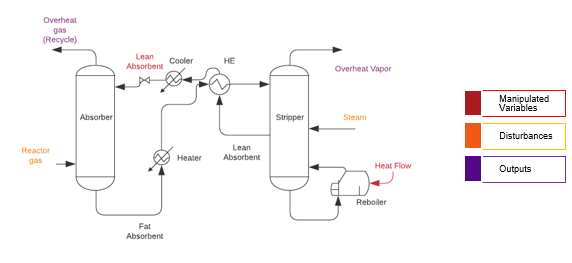
Model-based optimization of an Ethylene-Oxide recovery unit
Daniel Fernando Molina Sanchez
In the last century the production of Ethylene Oxide has evidence a trend which tends to be more mature as the demand of the sector is growing steadily. Due to the growing market, many interest had arisen for optimization in the production of this chemical. This work presents modelling techniques for a specific unit (Recovery unit) of the production of Ethylene Oxide. Reporting the development of a data driven system identification technique (sequential identification), using data from a reference model developed in Aspen Hysys v7.3 with preliminary information from literature. An optimization analysis is established for static and dynamic situation. Seeking for a reduction in the energy consumption and enhancement in the overall efficiency of the plant. Presenting different cost functions in the control-oriented problem. Finally, it presents how Matlab and Aspen Hysys can be interconnected, for an online optimization of models built in Aspen Hysys. Using Matlab as the main control tool for the Ethylene Oxide recovery plant. A standard model-based strategy is proposed in the form of a linear model predictive control (MPC). A stepwise set point tracking is employed to evaluate the performance of the proposed controller and compared with the performance of traditional local PID loops.
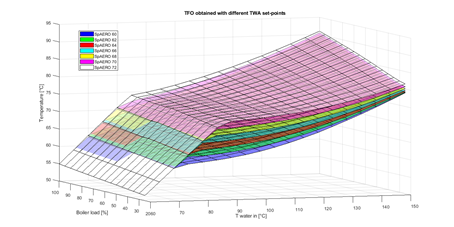
Analisi e controllo di un sistema di recupero del calore a tre stadi implementato su un generatore di vapore a tubi di fumo
Andrea Vianello
Nowadays, the interest in the optimization of energetic resources consumption and in the reduction of harmful emissions, pushes the manufacturing companies to study new technologies of energy recovery, and develop advanced control strategies to apply on production plants that consume high amount of fossil fuels such as Fire tube steam generators. The heat recovery device, called HE, is often connected to Fire tube boilers with the purpose of recovering the energy of the exhaust gases leaving the system. This thesis proposes a new control logic that regulate the operation of the HE device in order to maximize its efficiency. The static and dynamic response of the HE system controlled with the new regulator is analysed and compared with the performances carried out by the pre-existing control strategy already used in the industry. The case study is a three-stage heat recovery system implemented on a fire tube steam generator (model:SG-1000) produced by Bono Energia S.p.a.

Development of a hybrid mpc technique to increase the energy efficiency of a building heating system
Federico Ceruti
This thesis is focused on the development of a Hybrid MPC for the control of the heating system with radiators of a 3-floors building. This control strategy is implemented to minimize the thermal power exchanged by the radiators with the room, guaranteeing the user’s thermal comfort. To generate the hybrid MPC, it is required to build a hybrid model, able to describe the dynamics that govern the thermal exchanges that occur in the different zones. For the sake of simplicity and for data availability, only one zone per floor is considered, 3total zones, and one radiator per zone. The thermal model is developed with lumped parameters and it is sufficiently detailed to describe the prevailing dynamics of the system, moreover, this modelling choice allows a stronger physic representativeness of the results, on which the predictive control strategy will be developed. At first, the model is implemented in Matlab environment, in which a parameters identification is carried out. The identified parameters are those relative to the thermal characteristics of walls, pavements and ceiling and the remedial coefficient of the thermal power issued by the radiators. The identification is performed through a Grey-Box model, by analysing the 3 floors separately, to then report the estimated parameters in the whole model of the building. Subsequently, in Hysdel environment, through logical propositions, the hysteresis behaviour, that characterizes the progress of the temperature of each zone, is described and the model is made hybrid. To describe the hysteresis behaviour, Boolean variables and expressions related to the propositional calculus are exploited, and then are connected to the continuous thermal dynamics to generate an MLD model (Mixed Logical Dynamical), useful to the hybrid MPC. Once the hybrid MPC is developed, some simulations are performed, and the results obtained are compared with those got from the same hybrid system but regulated by a simple logic ON-OFF, and the advantages gained with the strategy of the predictive control are shown. Finally, two performances analysis are carried out, the first based on different constructive features of the building while the second based on different temperature set points imposed to the hysteresis. To conclude a robustness analysis, of the predictive control developed, is performed.
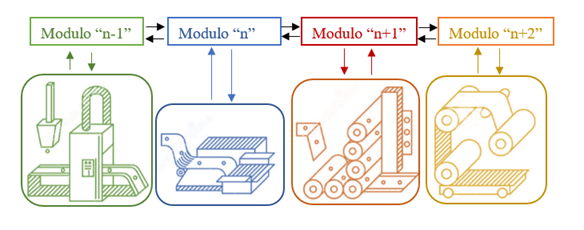
Standardizzazione della programmazione plc di una linea di laminazione
Claudio Pontecorvo
In questo lavoro di tesi viene realizzato uno studio volto alla standardizzazione della programmazione PLC di una linea di laminazione. I continui passi avanti fatti dalla tecnologia e la sempre crescente volontà di automatizzare le linee di produzione hanno portato alla necessità di dettare delle linee guida volte a standardizzare la scrittura di codice PLC. All’ interno del vasto mondo dell’automazione industriale già in molti si sono occupati di questo argomento. A seguito di un corposo lavoro di ricerca, è risultato valido ai nostri fini l’analisi dello standard PackML che, grazie alla sua rigorosa strutturazione della componentistica utilizzata e l’utilizzo di un modello a macchina a stati per la gestione della logica di macchina, è stata fonte di ispirazione per la nascita del nostro concetto di standard.
Il nostro progetto mira alla realizzazione di oggetti definiti “Moduli” che tramite interfaccia standard e ben definita permettano di controllare un gruppo di sensori e attuatori che cooperano alla realizzazione di una determinata funzione. Ben definito l’oggetto “Modulo” un ulteriore oggetto, chiamato “Unit”, realizzerà il livello di supervisione seguendo uno schema rigoroso dettato da una struttura Statechart. Al fine di testare la validità del lavoro realizzato e di effettuare delle valutazioni, che solo un’implementazione pratica avrebbe messo in evidenza, si è provveduto alla realizzazione di un prototipo. Grazie all’ utilizzo di sistemi di simulazione e di un ambiente di programmazione PLC è stato possibile mettere in pratica le linee guida dettate dallo standard realizzando una ipotetica linea di laminazione denominata “LAM-1” composta da “N” macchinari. La parte di controllo definita all’ interno PLC veniva poi completata dall’ implementazione del sistema di supervisione, implementato da un pannello HMI.

Data acquisition and analysis of energy efficiency in a classroom building
Arvind Jayakumar
The thesis initially gives a detailed comparison between the Internet of Things platform and then with the aid of the Node-RED IoT platform, a prototype model for acquiring data from the various sensor devices values form the InfluxDB database via IBM Node-RED platform is presented.
Based on the temperature and relative humidity values, the comfort indices care calculated, and scale of the comfort and value of each index are displayed in the user's dashboard. And by means of these indices, we can understand the condition of the classroom and how good are the HVAC system is working.
Then the collected data are analyzed and utilized for developing applications such as janitor service, current occupancy in a classroom, Average temperature, humidity, and CO2 for a floor are made.
Finally, the extension to the mobile platform and how we can utilize them in an efficient way is described.
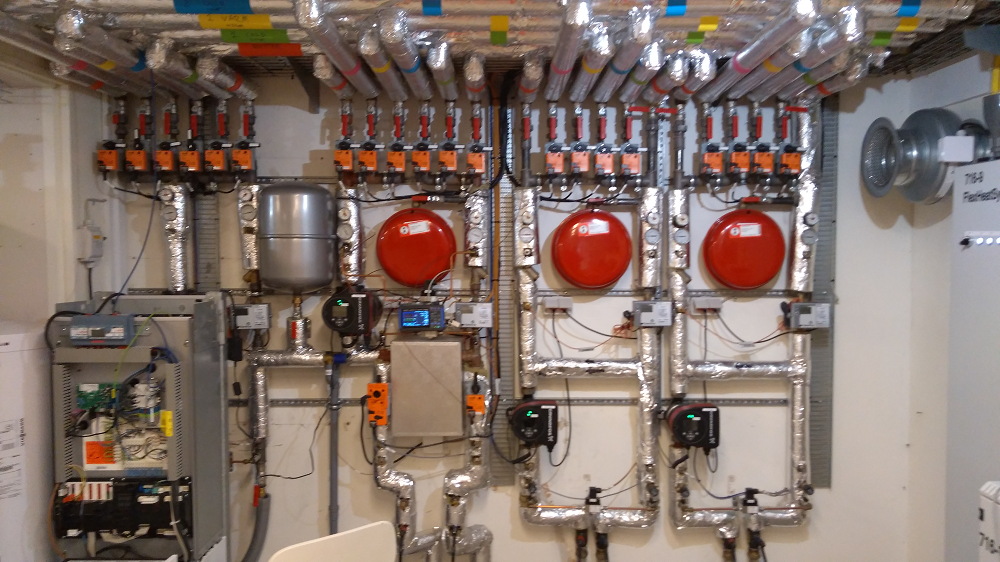
Model predictive control approach for energy efficiency in a building fed by heat pump
Lorenzo Caseri
Air-to-water heat pump is one of the most common and energy efficient way for a building heating system, particularly floor heating plants. One way to further improve its effectiveness is to control the heat pump exploiting the load dependency of its coefficient of performance (COP) in the control decision. This can be obtained predicting COP future behaviour, to anticipate heat pump impact on the building temperature. The performance of building temperature control is studied from an energy saving point of view. Model Predictive Control applications can further improve the performance of the control decision, to better anticipate the effects of disturbances and real-time pricing together with the future dynamics of the system under control. In the case studied, the load side, i.e. the building, and heating system are decoupled through a 3-element mixing valve, which enforces a fixed water flow rate in the building pipelines. The MPC can use the information of the building to manipulate the heating systems for feeding the building pipelines with hot water. The control action of the valve changes the dynamics in the water tank integrated with the heat pump, leading a nonlinear problem. Nonlinear model predictive control is used to deal with many physical constraints and the nonlinear problems. Alternatively, other linear MPC-based schemes are analysed for the specific case. The goal of the thesis is to study the advantages and disadvantages of MPC technique for temperature control in radiant-floor building fed by heat pump.

SCADA system for thermal and air quality comfort in an academic building
Miguel Ordonez
In this thesis a supervisory control system for an academic building is presented with a specific focus on comfort indexes such as temperature and air quality control. The proposed supervisory control system is a solution that has the same benefits as nowadays installed system enriched with more features such as scalability and communication with different types of control architectures.
Nowadays, PoliMi Building 25 has control system for temperature and air quality, whose feedback for the operator is the usual PID variables, like set point (SP), process value (PV) and controller output (U). However, there is a difference between this control problem and typical industrial control problems, in which it is desired to reach a specific value for a physical variable. In fact, in this case the system should provide comfort for the users, but for this purpose it is first needed to express comfort as a quantity.
Another disadvantage of the actual control architecture is its poor scalability and capacity to connect with other devices. This is mainly because the actual control system is a specific solution for temperature and air quality control with unique brand devices. However, in practice the constant evolution of the building requirements calls for a collaboration between the existing one and the most innovative ones coming from different brand devices and focused not only on temperature and air quality, but even on the processes of each laboratory, physical security, fire prevention systems, etc.
Finally, in case that the operator wants to export the data. This will be done with a sampling time of 30 minutes, making difficult it to analyze and study the information that the system can provide. The solution presented in this project overcome all these problems and a closer look on how it is done can be found.
Starting from a distributed sensors structure all over the rooms that need be controlled, with a collector for the data of the sensors, which later will send the information by a communication protocol to a graphical interface so that the operator has a feedback of the system.
A Supervisory Control and Data Acquisition (SCADA) system solution is presented, aiming this widely used technology for industrial processes, for a no so different problem even though it is not so applied. The SCADA system provides scalability with a large group of brands and devices to work with that can be easily attached by the different communication drivers.
The SCADA systems can be applied to different architectures, like a self-server or server and multi-client structure, depending on the dimension of the application. For the specific case of this thesis a self-server structure is implemented. All the data of the SCADA is stored in the selected server, which later can be archived, with a configurable sample time, for future analysis.
An approach to quantify the comfort in a room will be presented. The computation depends of an eligible number of comfort features, for the case of this project there are two comfort features: temperature and air quality.
The proposed solution will have all the features to solve the problematic but scaled to a DEMO as the control structure will be simulated by MATLAB and the SCADA will run in a virtual machine with a limited memory (50 GB). Even though, this is enough to prove the benefits of the solution.
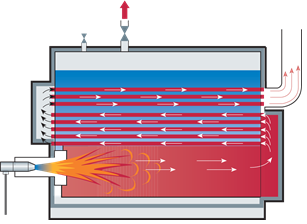
Model and control of a steam generator through an hybrid control structure
Mehdi Seraj Ansari
Almost every major industrial process includes a steam producer unit. Consequently, improving performance of the steam producers is appealing. On the other hand, recent technological improvements in the field of hardware makes it possible to implement advance control structures on the steam producers.
This thesis begins with introducing the model of a fire tube steam producer. Then the traditional control architecture of the plant is analyzed and a strategy for tuning its PI regulators is designed. This method can be applied to all the boilers of this type.
The performance of the system is affected by measurement noise on the water level and quantization on pressure measurements. A Kalman filter approach is introduced to tackle these problems and improve control action. The control actions have become smoother, which can extend effective life of actuators.
Then a new hybrid MPC controller is introduced and implemented. This hybrid control structure is able to improve the performance significantly.
The model of the plant and the control structure are implemented in MATLAB Simulink.
This work is focused on practical issues encountered on field on the control architecture of fire tube steam generators produced by Bono Energia S.p.A., model: SG-800.
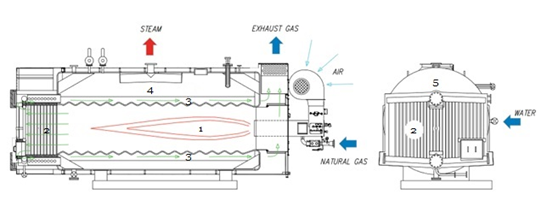
Modelling and Control of an Industrial Fire Tube Steam Generator
Davide Casartelli
In the past, fire tube and water tube steam generators were sized using models describing just the static behaviour of the plants.
Nowadays, the interest in efficiency improvement, in the reduction of consumption and emissions, pushes the manufacturing companies to study and to improve the behaviour of these machines also in non-stationary conditions. Therefore, the study of dynamic models becomes essential.
This thesis proposes a dynamic non-linear model of a fire tube steam generator, separately modelling the boiler and the heat recovery system, called “HE system”.
Furthermore, traditional control systems and model-based control systems are proposed, which have the purpose of improving the operations of the system both in stationary conditions and during transients.
The case study is a fire tube steam generator produced by Bono Energia S.p.A., model: SG-1000.















